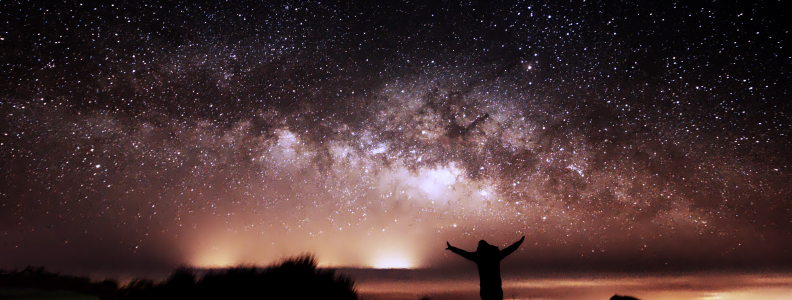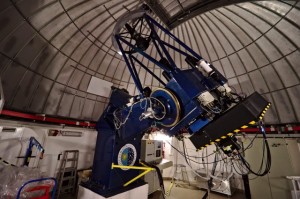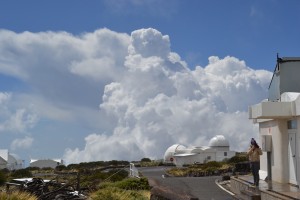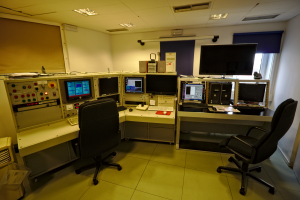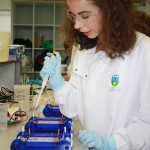Following on from her post “Preparing for My Observing Field Trip“, final-year Physics with Astronomy & Space Science student Lána Salmon provides her experiences at Teide Observatory as part of the Astronomy Field Trip module.
Arriving into sunny Tenerife on a Saturday afternoon, we took a few minutes to soak up the warmth before ascending 2500m up Mount Teide. Myself and 3 other Physics with Astronomy and Space Science final year students ventured to Teide Observatory, Tenerife for 5 nights with our lecturer Dr. Antonio Martin-Carrillo. Our final year projects hinge on the observations of our chosen objects using the 80cm IAC80 optical telescope.
Astronomers hope and pray for clear skies, and Teide Observatory is so high up that it is usually above the clouds. Unfortunately, as we ascended Mount Teide it became clear that the weather conditions weren’t optimal. There was freshly fallen snow on the mountain. You could really tell how high up you were as the buildings at sea level looked so small and it was a little harder to breathe as you walked around.
Unfortunately it snowed heavily on our first and second nights, meaning we couldn’t observe. During these nights we learned how to use the telescope and got a tour of the telescopes at Teide Observatory from the support astronomer. What amazed me was the number of telescopes and the amount of science going on in each – everything from measuring the remnants of the Big Bang to the third largest solar telescope in the world. Being in such an exciting place of astronomical research was really amazing.
Regardless of weather, we had a schedule for each day:
- 1pm: Wake up for lunch (or breakfast, depending on how you look at it!)
- 2-5pm: Free time – I usually took pictures or went for a walk (or nap!)
- 5pm: Meet at the telescope to take calibration images and schedule who would observe at what times that night.
- 7pm: Dinner
- 8pm: Start observations
- 8am: Watch the sunrise and go to bed!
With 4 hours sleep I found myself very tired but a combination of the excitement of being in such a remarkable place, the freezing cold outside and sugar kept me going.
We were blessed with clear skies for our third, fourth and fifth nights and finally got our first glimpse of the clear sky. I have never seen so many stars! No patch of the sky was empty, and constellations like Orion and the Plaeides were so bright. Although it was freezing outside(-3 degrees!), I spent half an hour looking at the stars and letting my eyes adjust to the darkness. I got my first glimpse of the Milky Way, and it did not dissappoint! Those views really showed me why I love astronomy, and why I have waited 4 years dreaming of this trip.
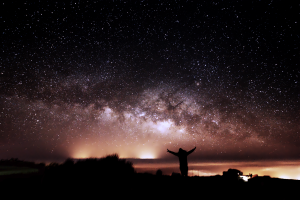
Me and the Milky Way, taken by our expedition leader and astrophotographer Dr Antonio Martin-Carrillo!
After dinner we quickly opened the dome while the skies were clear and began to observe. Each of us observed a different object – an interacting galaxy, a comet, exoplanet transit and binary star system. The four of us worked as a team in the telescope operations room, making sure to check that the images weren’t blurred and that the telescope was tracking the object across the sky. This was stressful – we were dealing with a very complicated piece of equipment and we needed to get everything up and running quickly in case the clouds came back. This was real hands-on experience and I was continually learning. Each time the exhaustion hit me I ventured outside to the cold to have a look at the Milky way, or the rising moon, or to sit in the silence and look at all the stars. The sunrise was the perfect end to a long but exciting night. Seeing the sun rise above the clouds below me was unlike any sunrise I’ve ever seen. Even though I was ready to collapse I found it hard to go asleep after seeing something so amazing.
Although the first 2 nights were disheartening and frustrating, we all got to observe in the end. The whole experience of using a real telescope to conduct our own research is an opportunity I will never forget. I learned a huge amount – how to operate a telescope, how to work in a team and the frustrating but exciting nature of optical astronomy. I found it difficult to settle back into normal life after such excitement, but I am inspired and enthusiastic to work on the data that I obtained at the observatory and write my thesis. I am currently analysing my data, and learning more and more each day. The real hands-on nature of science, and particularly astrophysics, is one of the reasons why I am passionate about it, and I am so grateful for this amazing opportunity. As my degree is coming to an end, I am looking back over all the work I have done and how it has all culminated with this trip. It is a rewarding end to 4 years of hard work and it exceeded every expectation.


